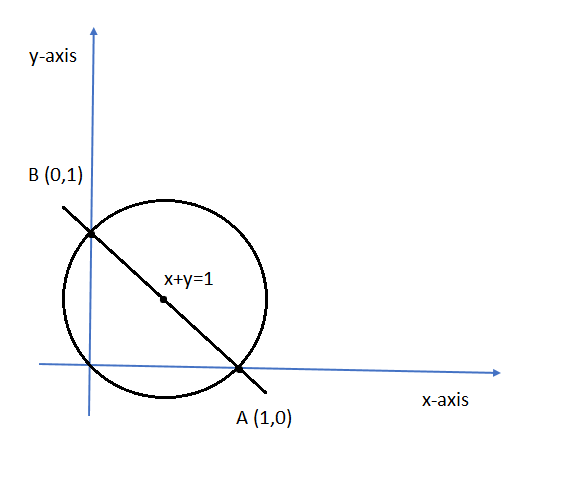
Centre and radius of the circle with segment of the line \[x + y = 1\] cut off by coordinate axes as diameter is:
A. \[\left( {\dfrac{1}{2},\dfrac{1}{2}} \right),\dfrac{1}{{\sqrt 2 }}\]
B. \[\left( {\dfrac{{ - 1}}{2},\dfrac{1}{2}} \right),\dfrac{1}{{\sqrt 2 }}\]
C. \[\left( {\dfrac{1}{2},\dfrac{{ - 1}}{2}} \right),\dfrac{1}{{\sqrt 2 }}\]
D. \[\left( {\dfrac{{ - 1}}{2},\dfrac{{ - 1}}{2}} \right),\dfrac{1}{{\sqrt 2 }}\]
Answer
598.2k+ views
Hint: First of all, find the point of intercepts made by the given line and the coordinate axes. Then draw a circle by taking the obtained points as endpoints of the diameter of the circle and hence find the radius and centre of the circle by using the midpoint formula.
Complete step-by-step solution -
To find intercepts of \[x + y = 1\] on the coordinate axis:
Put \[y = 0\], then
\[
\Rightarrow x + 0 = 1 \\
\therefore x = 1 \\
\]
And put \[x = 0\], then
\[
\Rightarrow 0 + y = 1 \\
\therefore y = 1 \\
\]
Thus, the points formed by the intercepts of the line \[x + y = 1\] on the coordinate axes are \[\left( {1,0} \right)\] and \[\left( {0,1} \right)\].
Let A = \[\left( {1,0} \right)\] and B = \[\left( {0,1} \right)\]
Now, draw a circle with the points A and B as end points of the diameter of the circle as shown in the figure:

So, length of the diameter of the circle = distance between the points A and B
We know that the distance between the two points \[\left( {{x_1},{y_1}} \right)\] and \[\left( {{x_2},{y_2}} \right)\] is given by \[\sqrt {{{\left( {{x_2} - {x_1}} \right)}^2} + {{\left( {{y_2} - {y_1}} \right)}^2}} \].
Therefore, the distance of AB \[ = \sqrt {{{\left( {0 - 1} \right)}^2} + {{\left( {1 - 0} \right)}^2}} = \sqrt {1 + 1} = \sqrt 2 \]
Hence, the diameter of the circle is \[\sqrt 2 \].
As, radius is equal to half of the length of diameter, radius of the circle \[ = \dfrac{{\sqrt 2 }}{2} = \dfrac{1}{{\sqrt 2 }}\]
Therefore, the radius of the circle is \[\dfrac{1}{{\sqrt 2 }}\].
We know that the centre of the circle is the midpoint of endpoints of diameter of the circle.
So, mid points of AB \[ = \left( {\dfrac{{1 + 0}}{2},\dfrac{{0 + 1}}{2}} \right) = \left( {\dfrac{1}{2},\dfrac{1}{2}} \right)\]
Therefore, the centre of the circle is \[\left( {\dfrac{1}{2},\dfrac{1}{2}} \right)\].
Thus, the correct option is A. \[\left( {\dfrac{1}{2},\dfrac{1}{2}} \right),\dfrac{1}{{\sqrt 2 }}\]
Note: The midpoint of the points \[\left( {{x_1},{y_1}} \right){\text{ and }}\left( {{x_2},{y_2}} \right)\] is given by \[\left( {\dfrac{{{x_1} + {x_2}}}{2},\dfrac{{{y_1} + {y_2}}}{2}} \right)\]. The distance between the two points \[\left( {{x_1},{y_1}} \right)\] and \[\left( {{x_2},{y_2}} \right)\] is given by \[\sqrt {{{\left( {{x_2} - {x_1}} \right)}^2} + {{\left( {{y_2} - {y_1}} \right)}^2}} \]. As the points formed by the line segment lie in the first quadrant, the centre of the circle also lies in the first quadrant.
Complete step-by-step solution -
To find intercepts of \[x + y = 1\] on the coordinate axis:
Put \[y = 0\], then
\[
\Rightarrow x + 0 = 1 \\
\therefore x = 1 \\
\]
And put \[x = 0\], then
\[
\Rightarrow 0 + y = 1 \\
\therefore y = 1 \\
\]
Thus, the points formed by the intercepts of the line \[x + y = 1\] on the coordinate axes are \[\left( {1,0} \right)\] and \[\left( {0,1} \right)\].
Let A = \[\left( {1,0} \right)\] and B = \[\left( {0,1} \right)\]
Now, draw a circle with the points A and B as end points of the diameter of the circle as shown in the figure:

So, length of the diameter of the circle = distance between the points A and B
We know that the distance between the two points \[\left( {{x_1},{y_1}} \right)\] and \[\left( {{x_2},{y_2}} \right)\] is given by \[\sqrt {{{\left( {{x_2} - {x_1}} \right)}^2} + {{\left( {{y_2} - {y_1}} \right)}^2}} \].
Therefore, the distance of AB \[ = \sqrt {{{\left( {0 - 1} \right)}^2} + {{\left( {1 - 0} \right)}^2}} = \sqrt {1 + 1} = \sqrt 2 \]
Hence, the diameter of the circle is \[\sqrt 2 \].
As, radius is equal to half of the length of diameter, radius of the circle \[ = \dfrac{{\sqrt 2 }}{2} = \dfrac{1}{{\sqrt 2 }}\]
Therefore, the radius of the circle is \[\dfrac{1}{{\sqrt 2 }}\].
We know that the centre of the circle is the midpoint of endpoints of diameter of the circle.
So, mid points of AB \[ = \left( {\dfrac{{1 + 0}}{2},\dfrac{{0 + 1}}{2}} \right) = \left( {\dfrac{1}{2},\dfrac{1}{2}} \right)\]
Therefore, the centre of the circle is \[\left( {\dfrac{1}{2},\dfrac{1}{2}} \right)\].
Thus, the correct option is A. \[\left( {\dfrac{1}{2},\dfrac{1}{2}} \right),\dfrac{1}{{\sqrt 2 }}\]
Note: The midpoint of the points \[\left( {{x_1},{y_1}} \right){\text{ and }}\left( {{x_2},{y_2}} \right)\] is given by \[\left( {\dfrac{{{x_1} + {x_2}}}{2},\dfrac{{{y_1} + {y_2}}}{2}} \right)\]. The distance between the two points \[\left( {{x_1},{y_1}} \right)\] and \[\left( {{x_2},{y_2}} \right)\] is given by \[\sqrt {{{\left( {{x_2} - {x_1}} \right)}^2} + {{\left( {{y_2} - {y_1}} \right)}^2}} \]. As the points formed by the line segment lie in the first quadrant, the centre of the circle also lies in the first quadrant.
Recently Updated Pages
Master Class 9 General Knowledge: Engaging Questions & Answers for Success

Master Class 9 English: Engaging Questions & Answers for Success

Master Class 9 Science: Engaging Questions & Answers for Success

Class 9 Question and Answer - Your Ultimate Solutions Guide

Basicity of sulphurous acid and sulphuric acid are

Master Class 12 Business Studies: Engaging Questions & Answers for Success

Trending doubts
Which places in India experience sunrise first and class 9 social science CBSE

Fill the blanks with the suitable prepositions 1 The class 9 english CBSE

Write the 6 fundamental rights of India and explain in detail

Difference Between Plant Cell and Animal Cell

What is pollution? How many types of pollution? Define it

What is the full form of pH?




